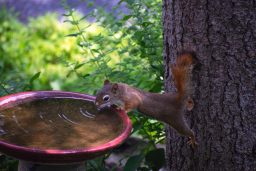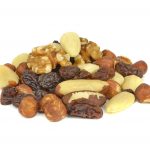Just like most mammals – squirrels can take to the water and cross streams and rivers with a sort of ‘doggy paddle’ movement. They don’t do it for fun though.
Can Squirrels Swim If They Are So Fluffy?

Squirrels don’t head out for a lovely relaxing swim on a warm sunny day as we do – they only swim if they really have to.
The fact that their beautifully designed fur coat needs to be dry to keep them warm – they won’t be getting it wet without good reason. Special fur traps air between the coat and their skin – keeping in warmth and slowing down the rate they lose heat. Once this gets wet – they lose all their insulation from it. Falling in the water in winter – even if they get straight out – could be a life or death situation.
However, quite often through the spring and summer – they can take to the water without such a risk. Also, choosing to go in the water – as opposed to falling – allows them to stay as dry as possible and keep their breathing regulated. They can see where they are going and then upon leaving the water on the other side – they have enough environmental warmth to dry their fur and carry on as normal.
Squirrels often swim with their tail held high in the air – and this appendage is really important and needs to be fluffed out. Their tails are believed to not only work as a sunshade, but also a defense/camouflage mechanism (if approached from behind). Also, tails are very important in balance and signalling – so again – really benefit from staying totally dry and fluffy.
Why Would A Squirrel Want To Swim?
If squirrels don’t like getting wet – why do they swim in the first place? Great question.
Ideally – they would be up in the trees – so swimming isn’t often a choice. However, there are a few really important reasons why the water might seem their best option.
1) Escape From A Predator
Yes, the time-old challenge of escaping death by risking your life elsewhere. If they were caught off guard by a predator beside a river – out of the jumping distance of a tree – then jumping into a body of water instead seems like the better option from running towards the predator? Fleeing anywhere seems like a decent plan in a moment of panic – so they just jump in. It doesn’t always go as well as a planned swim – as they may get totally dunked; could swallow water; get caught in rapids; etc, but it is certainly worth the risk at the time.
2) Find A New Home
Often after a bumper feast year – say when there were massive acorn and mast years and fantastic warm weather – or a lack of natural predators in that area – there will be an abundance of baby squirrels the following year. Great short term for the squirrels as they are all happy and ready for the new year – but then they find there aren’t enough trees or homes for everyone when they grow up – so they have to migrate. And this may take them across a river.
3) Find Food

If there isn’t a good year, however – or indeed there is a famine – then these squirrels might have to make the decision to head off for pastures new. It isn’t unusual for the landscape to change over a few years or decades, and what worked before for squirrels doesn’t work anymore. Maybe there was a forest fire, a flood, a change of land use, or a new housing estate. The migration of animals is very similar to our own reasons.
What Are Some Foods That Can Be Used to Lure Squirrels and Chipmunks Near Water?
Feeding squirrels and chipmunks examples near water include nuts, such as peanuts and walnuts, as these critters are naturally attracted to them. Fruits like apples and berries can also entice them. Additionally, seeds like sunflower seeds and corn kernels are great options that can lure squirrels and chipmunks to your desired location.
How Far Can Squirrels Swim?
Quite some distance if they need to – well you can’t just stop swimming once you are in the water, can you?
One squirrel was once found well over 250 meters out to an inland sea without showing any signs of distress when it was spotted – tail held high. It is also thought that they can swim further too – especially based on some of the islands they have colonized in the past.
They must be able to disperse to new landscapes when needed – and obviously, the strongest swimmers were more likely to travel their furthest. This meant that their successful genes stayed in the gene pool – improving the chances of their offspring being great swimmers too!









